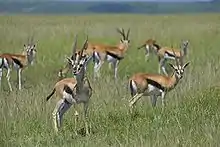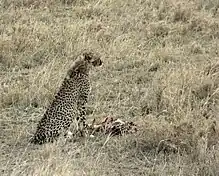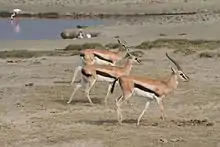Thomson's gazelle
Thomson's gazelle (Eudorcas thomsonii) is one of the best-known gazelles. It is named after explorer Joseph Thomson and is sometimes referred to as a "tommie".[2] It is considered by some to be a subspecies of the red-fronted gazelle and was formerly considered a member of the genus Gazella within the subgenus Eudorcas, before Eudorcas was elevated to genus status.[3] Thomson's gazelles can be found in numbers exceeding 200,000[1] in Africa and are recognized as the most common type of gazelle in East Africa. The Thomson's gazelle can reach speeds of 80–90 km/h (50–55 mph). It is the fourth-fastest land animal, after the cheetah (its main predator), pronghorn, and springbok.[2]
| Thomson's gazelle | |
|---|---|
 | |
| Male | |
| Scientific classification | |
| Kingdom: | Animalia |
| Phylum: | Chordata |
| Class: | Mammalia |
| Order: | Artiodactyla |
| Family: | Bovidae |
| Subfamily: | Antilopinae |
| Genus: | Eudorcas |
| Species: | E. thomsonii |
| Binomial name | |
| Eudorcas thomsonii (Günther, 1884) | |
 | |
| Distribution range | |
Taxonomy and etymology
The scientific name of Thomson's gazelle is Eudorcas thomsonii. It is a member of the genus Eudorcas and is classified under the family Bovidae. Thomson's gazelle was first described by British zoologist Albert Günther in 1884.[4] The relationships between Thomson's gazelle and the congeneric Mongalla gazelle (E. albonotata) remain disputed; while some authors such as Alan W. Gentry of the (Natural History Museum, London) consider the Mongalla gazelle to be a subspecies of Thomson's gazelle,[4][5] others (such as Colin Groves) consider the Mongalla gazelle to be a full species.[6] Zoologist Jonathan Kingdon treated Heuglin's gazelle, sometimes considered a species of Eudorcas (E. tilonura) or a subspecies of the red-fronted gazelle (E. r. tilonura), as a subspecies of Thomson's gazelle.[7] Thomson's gazelle is named after the Scottish explorer Joseph Thomson; the first recorded use of the name dates to 1897.[8] Another common name for the gazelle is "tommy".[9]
| |||||||||||||||||||||||||||||||||||||||||||||||||
Antilope, Eudorcas, Gazella, and Nanger form a clade within their tribe Antilopini. A 1999 phylogenetic analysis showed that Antilope is the closest sister taxon to Gazella,[10] although the earliest phylogeny, proposed in 1976, placed Antilope as sister to Nanger.[11] In a more recent revision of the phylogeny of the Antilopini on the basis of nuclear and mitochondrial data in 2013, Eva Verena Bärmann (of the University of Cambridge) and colleagues constructed a cladogram that clearly depicted the close relationship between Nanger and Eudorcas. Antilope and Gazella were found to have a similar relationship.[12][13]
Two subspecies are identified:[6][14]
- E. t. nasalis (Lönnberg, 1908) – Serengeti Thomson's gazelle ranges from the Serengeti to the Kenya Rift Valley.
- E. t. thomsonii (Günther, 1884) – eastern Thomson's gazelle ranges from east of the Rift Valley in Kenya and Tanzania, southward to Arusha District (Tanzania) and then southwestward to Lake Eyasi, Wembere River, and Shinyanga.
Description

Thomson's gazelle is a relatively small gazelle; it stands 60–70 cm (24–28 in) at the shoulder. Males weigh 20–35 kg (44–77 lb), while the slightly lighter females weigh 15–25 kg (33–55 lb). Facial characteristics of the gazelle include white rings around the eyes, black stripes running from a corner of the eye to the nose, rufous stripes running from the horns to the nose, a dark patch on the nose, and a light forehead.[15][16]

The coat is sandy brown to rufous; a distinctive black band runs across the flanks, from the upper foreleg to just above the upper hind leg. A buff band can be seen just above the black stripe. Short, black streaks mark the white rump. The black tail measures 15–27 cm (5.9–10.6 in). Males have well-developed preorbital glands near the eyes, which are used for scent-marking territories. Both sexes possess horns that curve slightly backward with the tips facing forward. The horns, highly ringed, measure 25–43 cm (9.8–16.9 in) on males and 7–15 cm (2.8–5.9 in) on females. However, females have highly fragile horns; some are even hornless.[7][15] Grant's gazelle is very similar to Thomson's gazelle, but can be differentiated by its larger size and a large white patch on the rump.[16]
The two subspecies differ markedly in their appearance. The eastern Thomson's gazelle is the larger of the two, with fainter facial markings. The Serengeti Thomson's gazelle, though, has a whiter face with more conspicuous markings. The horns of females are shorter than those of males to a greater degree in the eastern Thomson's gazelle; moreover, the horns are more divergent in the eastern Thomson gazelle.[6]
Ecology

Thomson's gazelle lives in Africa's savannas and grassland habitats, particularly the Serengeti region of Kenya and Tanzania. It has narrow habitat preferences, preferring short grassland with dry, sturdy foundation.[17] It does, however, migrate into tall grassland and dense woodland.[17] Gazelles are mixed feeders.[17] In the wet seasons, they eat mainly fresh grasses,[18] but during the dry seasons, they eat more browse,[18] particularly foliage from bushes, forbs, and clovers.[17]


Thomson's gazelles are dependent on short grass.[18] Their numbers are highly concentrated at the beginning of the rains since the grass grows quickly.[18] They follow the larger herbivores, such as plains zebras and blue wildebeests as they mow down the tall grasses.[18] Then, the gazelles spread out more.[18] In the wild, Thomson's gazelles can live 10–15 years. Their major predators are cheetahs, which are able to attain higher speeds, but gazelles can outlast them in long chases and are able to make turns more speedily.[19] This small antelope-gazelle can run extremely fast, from 80 km/h (50 mph),[20] to 96 km/h (60 mph)[21] and zigzag, a peculiarity which often saves it from predators. Sometimes, they are also chased by leopards, lions, and hyenas, but the gazelles are faster and more agile; these predators attack especially the young or infirm individuals. They can also be prey to Nile crocodiles and African rock pythons, and their fawns are sometimes the prey of eagles, African wild dogs, jackals, and baboons. A noticeable behaviour of Thomson's gazelles is their bounding leap, known as stotting or pronking, used to startle predators and display strength.
Social behavior


During the wet season, a time when grass is abundant, adult male gazelles graze extensively. They spread out more and establish breeding territories.[22] Younger males usually spend their time in bachelor groups, and are prevented from entering the territories.[23] Females form migratory groups that enter the males' territories, mostly the ones with the highest-quality resources.[23] As the female groups pass through and forage, the territorial males may try to herd them, and are usually successful in preventing single females from leaving, but not whole groups.[17][23] Subadult males usually establish dominance through actual combat, while adults are more likely to do rituals.[17] If a bachelor male should be passing through a territorial male's region, the male will chase the offender out of his territory.[17]
When patrolling his territory, a male may use his horns to gore the grass, soil, or a bush.[24] Males also mark grass stems with their preorbital glands, which emit a dark secretion.[17][24] Territories of different males may share a boundary. When territorial males meet at the border of their territories, they engage in mock fights in which they rush towards each other as if they are about to clash, but without touching.[24] After this, they graze in a frontal position, then in parallel and then in reverse, and move away from each other while constantly grazing.[24] These rituals have no victor, but merely maintain the boundaries of the territories.[24] Territorial males usually do not enter another male's territory. If a male is chasing an escaping female, he will stop the chase if she runs into another territory, but the neighboring male will continue the chase.[24]
Reproduction and parental care
.jpg.webp)

A male gazelle follows a female and sniffs her urine to find out if she is in estrus, a process known as the Flehmen response.[25] If so, he continues to court and mount her.[24] Females leave the herd to give birth to single fawns after a five- to six-month gestation period.[26] They give birth twice yearly with one or two fawns.[18] When birthing, a female gazelle crouches as the newborn fawn drops to the ground, tearing the umbilical cord.[27] The mother then licks the fawn clean of amniotic fluid and tissues.[27] In addition, licking possibly also serves to stimulate the fawn's blood circulation, or to "label" it so its mother can recognize it by scent.[27]
In the first six hours of the fawn's life, it moves and rests with its mother, but eventually spends more time away from its mother or hides in the grass.[27] The mother stays in the vicinity of the fawn and returns to nurse it daily. Mother and fawn may spend an hour together before the fawn goes and lies back down to wait for the next nursing.[27] Mother gazelles may associate with other gazelle mothers, but the fawns do not gather into "kindergartens".[27] Mothers defend their young against jackals and baboons, but not against larger predators. Sometimes, a female can fend off a male baboon by headbutting him with her horns to defend her fawn.
Females exhibit pre-retrieval peaks in maternal vigilance. This behavior is conspicuous. Females all but cease other activities in favor of vigilance. They move slowly in the direction of the fawn’s hiding spot, stopping frequently to scan the environment. Several females in our observations engaged in “sham” feeding behavior, in which they lowered their heads to the ground as if to feed before quickly raising them back up to scan. In one instance, a female appeared to actively search for predators by climbing to the top of a slight hill to scan prior to approaching her fawn’s hiding spot.[28]
As the fawn approaches two months of age, it spends more time with its mother and less time hiding. Eventually, it stops hiding.[27] Around this time, the fawn starts eating solid food, but continues to nurse from its mother.[27] The pair also joins a herd. Young female gazelles may associate with their mothers as yearlings.[27] Young males may also follow their mothers, but as they reach adolescence, they are noticed by territorial males, so cannot follow their mothers into territories. The mother may follow and stay with him, but eventually stops following him when he is driven away; the male will then join a bachelor group.[27]
Status

The population estimate is around 550,000. The population had declined 60% from 1978 to 2005.[29] Threats to Thomson's gazelles are tourist impacts, habitat modification, fire management, and road development.[1] Surveys have reported steep declines (60-70%) over periods of about 20 years dating from the late 1970s in several places, including the main strongholds for the species: Serengeti, Masai Mara, and Ngorongoro.[1]
Cultural references
References to the Thomson's gazelle were an occasional running gag in Monty Python's Flying Circus.
The 2016 Disney film Zootopia features an anthropomorphic Thomson's gazelle pop star, voiced by Shakira.
The Thomson's gazelle served as the inspiration for Alexander McQueen's 1997 Autumn/Winter collection, It's a Jungle Out There.[30]
See also
- Springbok, a similar species
References
- IUCN SSC Antelope Specialist Group. 2018. Eudorcas thomsonii. The IUCN Red List of Threatened Species 2018: e.T8982A50188023. https://dx.doi.org/10.2305/IUCN.UK.2018-2.RLTS.T8982A50188023.en. Downloaded on 18 December 2018.
- "Thomson's Gazelle". African Wildlife Foundation. 2013-02-22.
- Kingdon, Jonathan (1997). The Kingdon Field Guide to African Mammals. San Diego and London:Academic Press. pp. 411–413. (ISBN 0-12-408355-2)
- Wilson, D.E.; Reeder, D.M., eds. (2005). Mammal Species of the World: A Taxonomic and Geographic Reference (3rd ed.). Johns Hopkins University Press. p. 679. ISBN 978-0-8018-8221-0. OCLC 62265494.
- "Eudorcas albonotata". Integrated Taxonomic Information System. Retrieved 24 April 2016.
- Groves, C.; Grubb, P. (2011). Ungulate Taxonomy. Baltimore, USA: Johns Hopkins University Press. p. 179. ISBN 978-1-4214-0093-8.
- Kingdon, J. (2015). The Kingdon Field Guide to African Mammals (2nd ed.). London, UK: Bloomsbury Publishing. pp. 563–4. ISBN 978-1-4729-2135-2.
- "Thomson's Gazelle". Merriam-Webster Dictionary. Retrieved 24 April 2016.
- Kingdon, J. (1989). East African Mammals: An Atlas of Evolution in Africa. 3. London, UK: Academic Press. pp. 403–13. ISBN 978-0-226-43725-5.
- Rebholz, W.; Harley, E. (July 1999). "Phylogenetic relationships in the bovid subfamily Antilopinae based on mitochondrial DNA sequences". Molecular Phylogenetics and Evolution. 12 (2): 87–94. doi:10.1006/mpev.1998.0586. PMID 10381312.
- Effron, M.; Bogart, M. H.; Kumamoto, A. T.; Benirschke, K. (1976). "Chromosome studies in the mammalian subfamily Antilopinae". Genetica. 46 (4): 419–44. doi:10.1007/BF00128089. S2CID 23227689.
- Bärmann, E.V.; Rössner, G.E.; Wörheide, G. (2013). "A revised phylogeny of Antilopini (Bovidae, Artiodactyla) using combined mitochondrial and nuclear genes". Molecular Phylogenetics and Evolution. 67 (2): 484–93. doi:10.1016/j.ympev.2013.02.015. PMID 23485920.
- Considine, G.D.; Kulik, P.H., eds. (2008). Van Nostrand's Scientific Encyclopedia (10th ed.). New Jersey, USA: Wiley-Interscience. p. 183. ISBN 978-0-471-74398-9.
- "Eudorcas thomsonii". Integrated Taxonomic Information System. Retrieved 24 April 2016.
- Castelló, J.R. (2016). Bovids of the World: Antelopes, Gazelles, Cattle, Goats, Sheep, and Relatives. Princeton, USA: Princeton University Press. pp. 104–7. ISBN 978-1-4008-8065-2.
- Foley, C.; Foley, L.; Lobora, A.; De Luca, D.; Msuha, M.; Davenport, T.R.B.; Durant, S.M. (2014). A Field Guide to the Larger Mammals of Tanzania. Princeton, USA: Princeton University Press. p. 212. ISBN 978-1-4008-5280-2.
- Estes, R. (1991). The Behavior Guide to African Mammals, Including Hoofed Mammals, Carnivores, Primates. Los Angeles, The University of California Press. pgs. 70-75
- Kingdon, J. (1979). East African Mammals: An Atlas of Evolution in Africa, Volume 3, Part. D: Bovids. University Chicago Press, Chicago pgs. 403–413.
- "Cheetah cubs vs gazelle - BBC wildlife". YouTube.
- Natural History Magazine (March 1974). The American Museum of Natural History; and James G. Doherty, general curator, The Wildlife Conservation Society
- "Maxisciences, le record de vitesse de la gazelle de Thomson a été enregistré à 94,2 km/h". Gentside Découverte (in French). Archived from the original on 2014-10-22. Retrieved 2012-10-17.
- Walther, F. R. (1977). "Sex and Activity Dependency of Distances Between Thomson's Gazelles (Gazella Thomsoni Gunther 1884)". Animal Behaviour. 25 (3): 713–719. doi:10.1016/0003-3472(77)90120-8. S2CID 53181151.
- Jarman, P. J. (1974). "The Social Organization of Antelope in Relation to their Ecology". Behaviour. 48 (3–4): 215–267. doi:10.1163/156853974x00345. S2CID 83588927.
- Walther, Fritz (1995). In the Country of Gazelles, Chapter 1; "Short-tail and Roman", pp. 1-37. Indiana University Press.
- Hart, Lynette A., and Benjamin L. Hart. "Species-specific patterns of urine investigation and flehmen in Grant's gazelle (Gazella granti), Thomson's gazelle (G. thomsoni), impala (Aepyceros melampus), and eland (Taurotragus oryx)." Journal of Comparative Psychology 101.4 (1987): 299.
- Estes, R. D. (1967). "The Comparative Behavior of Grant's and Thomson's Gazelles". Journal of Mammalogy. 48 (2): 189–209. doi:10.2307/1378022. JSTOR 1378022.
- Walther, Fritz (1995). In the Country of Gazelles, Chapter 6: "On mothers and their young", pp. 94-113. Indiana University Press.
- Costelloe, Blair R.; Rubenstein, Daniel I. (2018). "Temporal structuring of vigilance behavior by female Thomson's gazelles with hidden fawns". 1. Department of Collective Behaviour, Max Planck Institute for Ornithology 2. Department of Biology, University of Konstanz 3. Department of Ecology and Evolutionary Biology, Princeton University.
- East, R. (1999). African Antelope Database IUCN, Gland, Switzerland and Cambridge, UK.
- Wilson, Andrew (2015). Alexander McQueen: Blood Beneath the Skin. New York, USA: Simon & Schuster. p. 179. ISBN 978-1-4767-7673-6.
Further reading
| Wikimedia Commons has media related to: |
| Wikispecies has information related to Gazella thomsonii. |
- Gazelles and Their Relatives by Fritz Walther (1984)

_Gazella_isabella_(white_background).png.webp)
_Antilope_cervicapra_(white_background).png.webp)
_Gazella_rufifrons_(white_background).png.webp)
_Gazella_thomsoni_white_background.png.webp)
_Gazella_granti_(white_background).png.webp)
_Gazella_mhorr_(white_background).png.webp)
_Lithocranius_walleri_(white_background).png.webp)
_Antidorcas_euchore_(white_background).png.webp)